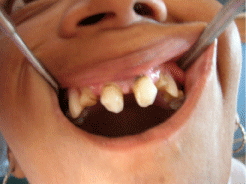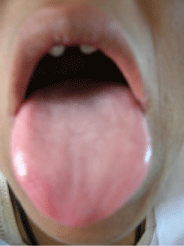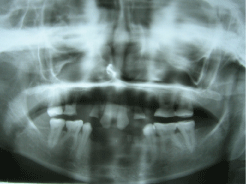
Clinical Image
Austin J Dent. 2018; 5(3): 1109.
Ectodermal Dysplasia- An Entity with Multifaceted Presentations
Kashyap B¹* and Sridhar Reddy P²
¹Department of Oral Pathology, Buraydah Private Dental College, Saudi Arabia
²Department of Oral & Maxillofacial Surgery, Buraydah Private Dental College, Saudi Arabia
*Corresponding author: Kashyap B, Department of Oral Pathology, Buraydah Private Dental College, Buraydah, Saudi Arabia
Received: January 22, 2018; Accepted: February 12, 2018; Published: March 05, 2018
Clinical Image
A 19 year old female patient reported to the outpatient department with a chief complaint of replacement of her lost teeth. Her medical, dental and family history was non - contributory. She noticed that her mouth has only 14 teeth in total in spite of 28 or 32. She also gives history of burning sensation of tongue and difficult to swallow food occasionally. Her parents did not notice any symptoms, exfoliation of teeth and ignored as their child was apparently normal. Patient became conscious about her teeth due to her upcoming marriage. She wanted replacement of the spacing in between the teeth with the prosthesis. On extraoral examination, patient appeared moderately nourished with sparse hair and brittle nails. Her vital signs were within normal limits. On further questioning she gave the history of less sweating during summers and dry skin. Complete blood examination was done which revealed all the values within normal limits except heamoglobin which was 8 gm%. Intraoral examination revealed oligodontia, bald tongue and xerostomia (Figure 1 and 2). Patient was advised for the panoramic radiograph to check for the developing permanent tooth buds, but no tooth buds were evident (Figure 3). Chair side salivary flow test was done both at rest (Normal-0.3 ml/min) and at stimulation (Normal-2 ml/min), which revealed low values, hence confirming xerostomia. Considering her clinical and dental finding a diagnosis of hereditary ectodermal dysplasia was confirmed.

Figure 1:

Figure 2:
Hereditary ectodermal dysplasia
Ectodermal dysplasias are varied group of inheritted disorders with many coinciding features, which makes difficult for clinicians & researchers to classify them. The heterogenous nature of Ectodermal dysplasias involves deformities of two or more structures such as the hair, teeth, nails, sweat glands, cranial-facial structure, digits and other ectodermally derieved parts of the body. According to Freire-Maia’s classification (Group A & Group B), the present case falls into Group A Ectodermal dysplasia with subtype 1-2-3-4 with the principal signs like hyohydrosis, hypotrichosis and hypodontia [1]. Considering the clinical manifestations of the disease which can cause significant social problems in affected individuals, a palliative customized treatment approach with a team of oral pathologist, oral surgeon, prosthodontist, dermatologist, and psychologist is recommended [2]. The patient in the present case was treated with the prosthesis, multivitamins, salivary stimulus, and special hair care along with genetic counselling. An early diagnosis & recuperation with the multidisciplinary approach is considered the fundamental to manage ectodermal dysplasia successfully.
